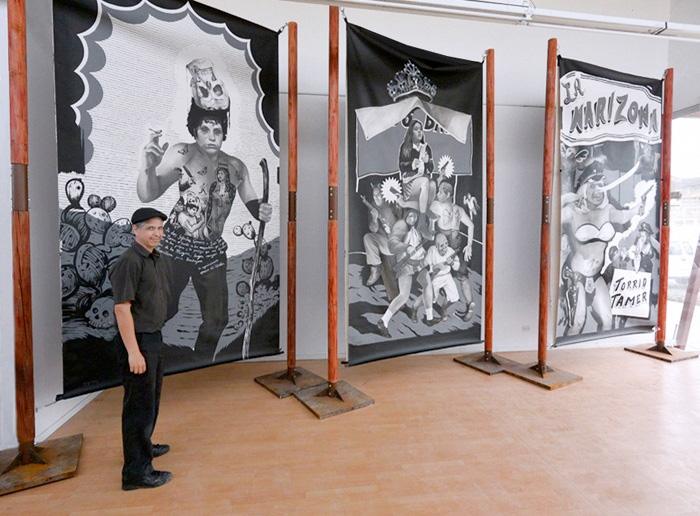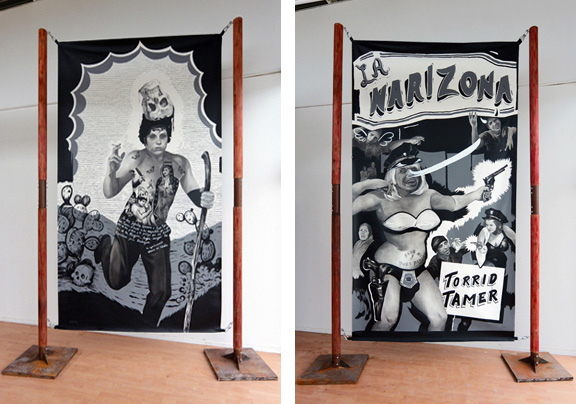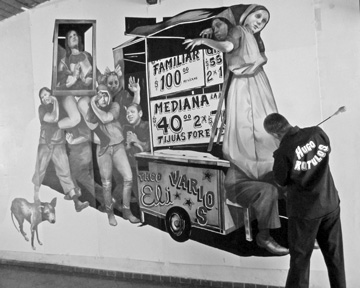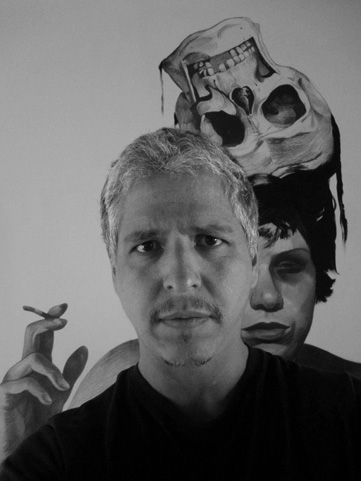
HUGO CROSTHWAITE: CARPAS
to premier at the 2013 CALIFORNIA-PACIFIC TRIENNIAL
curated by Dan Cameron
Orange County Museum of Art, Newport Beach, California
June 30 - November 17, 2013
curated by Dan Cameron
Orange County Museum of Art, Newport Beach, California
June 30 - November 17, 2013
Hugo Crosthwaite Studios is pleased to announce the premiere of a new large-scale installation by Hugo Crosthwaite entitled CARPAS, created for the 2013 California-Pacific Triennial at the Orange County Museum of Art. The exhibition will open to the public on Sunday, June 30th and remain on view through November 17, 2013. This first iteration of the California-Pacific Triennial has been curated by Dan Cameron, Chief Curator.
Crosthwaite's "Carpas" installation will be located in the main entrance of the Museum and will feature a series of unique hand-painted canvas banners, wall drawings and circus lights, recreating the stimulating sensation of entering a traditional carpas (tent theater). The banners, painted and drawn in graphite, charcoal, and acrylic paint on canvas, will stand opposite a monumental wall mural and will be individually suspended between wooden poles anchored to iron bases. With circus lights strung above, a walkway is created in which visitors can enter the dialogue between the inward-facing works.

The three freestanding banners, measuring 12 x 9 x 2 feet each, will feature stock characters central to Mexican carpas shows, such as the pelado (the everyday poor), the pretty lady/heroine, and the bourgeois/authorities. The banners are titled "El Pelado", "Miss Bala, and "La Narizona".
The Pelado represents the underdog, the clown, the central character of the Carpas performance, and the figure who carries the moral weight of the story--in this case, the migrant worker. "Miss Bala", or Miss Bullet, represents the pretty lady, love interest and damsel in distress. It is an image of innocence, the victim of menacing, corrupt and violent forces, being held aloft and carried off by narco-trafficers. "La Narizona", representing the corrupt policeman, is slang for "big nose", a pejorative for a liar and a play on words--nariz (nose) and Arizona. It is assigned to the bad-cop likeness of Governor Jan Brewer of Arizona as well as Annie Oakley, the fastest gun in the West. (A detailed description of the banners, its characters and subject matter, is available upon request.)

Crosthwaite will be on site at the Museum during the installation week leading up to the opening to work on the monumental mural, which will measure approximately 18 ft. wide x 12 ft. high.
The mural will feature a central large "cut-out" drawing (114 inches by 144 inches) created on acid-free museum board depicting a scene of Tijuana citizens marching in a procession towards the carpa. Additional drawings will augment this central scene.
In addition to the installation, the Museum will present four smaller drawings by Crosthwaite in one of the main galleries. These acrylic and graphite drawings on clay board measure 16 x 20 inches each and further comment on the daily struggles of the working-class.
CARPAS banners (double-sided): El Pelado, Miss Bala and La Narizona.
Medium: Graphite, charcoal, and acrylic on canvas; wooden poles, iron base, hardware
Canvas: 10.5 x 6 feet (127 x 73 inches) each
Installed: 12 x 9 x 2 feet (144 x 108 x 24 inches) each

HISTORY:
Hugo Crosthwaite's Carpas installation take inspiration from the carpa theater that flourished in Mexico and the Southwestern United States during the 1920s and 30s. Like its American counterpart vaudeville, performances were varied, including comedic sketches, political satire, acrobatics, and dance. These temporary theaters allowed Mexico's urban underclass to forget their daily troubles and were encouraged by the government as an alternative to the pulque hall and the brothel.
The carpas, groups of itinerant performers, moved their collapsible stages from town to town, setting up in the main square or the middle of a street and presenting a program that spoke directly to their mixed-class audience. Shows usually consisted of three tandas, or acts. In order to be successful on the carpa stage, an actor had to establish an immediate rapport with the audience and get laughs quickly or risk being booed off stage. This limited the portrayals to stock characters and there was a relaxed, informal atmosphere in which the audience and the performers engaged each other directly.
The material presented in the carpas was highly satirical and frequently political in nature. The central character, the pelado is the Mexican national clown. A penniless underdog, he brought the popular concerns and spirit ignored by official society into performance. The pelado improvised comic routines on such topics as the high cost of living, political scandals, and treacherous political leaders. The most famous pelado was Cantinflas, whose comedy was based upon the peculiarly Mexican way of speaking-a relentless verbal dexterity, not always making sense but demonstrating a wry, rascally humor rift with class-conscious satire.
Crosthwaite's "Carpas" installation will be located in the main entrance of the Museum and will feature a series of unique hand-painted canvas banners, wall drawings and circus lights, recreating the stimulating sensation of entering a traditional carpas (tent theater). The banners, painted and drawn in graphite, charcoal, and acrylic paint on canvas, will stand opposite a monumental wall mural and will be individually suspended between wooden poles anchored to iron bases. With circus lights strung above, a walkway is created in which visitors can enter the dialogue between the inward-facing works.

Hugo Crosthwaite, Carpas (right: "La Narizona"; left: "El Pelado"), 2013
Acrylic, charcoal, graphite on canvas; wood, steel; 12 x 9 x 2 feet each
Acrylic, charcoal, graphite on canvas; wood, steel; 12 x 9 x 2 feet each
The three freestanding banners, measuring 12 x 9 x 2 feet each, will feature stock characters central to Mexican carpas shows, such as the pelado (the everyday poor), the pretty lady/heroine, and the bourgeois/authorities. The banners are titled "El Pelado", "Miss Bala, and "La Narizona".
The Pelado represents the underdog, the clown, the central character of the Carpas performance, and the figure who carries the moral weight of the story--in this case, the migrant worker. "Miss Bala", or Miss Bullet, represents the pretty lady, love interest and damsel in distress. It is an image of innocence, the victim of menacing, corrupt and violent forces, being held aloft and carried off by narco-trafficers. "La Narizona", representing the corrupt policeman, is slang for "big nose", a pejorative for a liar and a play on words--nariz (nose) and Arizona. It is assigned to the bad-cop likeness of Governor Jan Brewer of Arizona as well as Annie Oakley, the fastest gun in the West. (A detailed description of the banners, its characters and subject matter, is available upon request.)

Crosthwaite will be on site at the Museum during the installation week leading up to the opening to work on the monumental mural, which will measure approximately 18 ft. wide x 12 ft. high.
The mural will feature a central large "cut-out" drawing (114 inches by 144 inches) created on acid-free museum board depicting a scene of Tijuana citizens marching in a procession towards the carpa. Additional drawings will augment this central scene.
In addition to the installation, the Museum will present four smaller drawings by Crosthwaite in one of the main galleries. These acrylic and graphite drawings on clay board measure 16 x 20 inches each and further comment on the daily struggles of the working-class.
CARPAS banners (double-sided): El Pelado, Miss Bala and La Narizona.
Medium: Graphite, charcoal, and acrylic on canvas; wooden poles, iron base, hardware
Canvas: 10.5 x 6 feet (127 x 73 inches) each
Installed: 12 x 9 x 2 feet (144 x 108 x 24 inches) each

HISTORY:
Hugo Crosthwaite's Carpas installation take inspiration from the carpa theater that flourished in Mexico and the Southwestern United States during the 1920s and 30s. Like its American counterpart vaudeville, performances were varied, including comedic sketches, political satire, acrobatics, and dance. These temporary theaters allowed Mexico's urban underclass to forget their daily troubles and were encouraged by the government as an alternative to the pulque hall and the brothel.
The carpas, groups of itinerant performers, moved their collapsible stages from town to town, setting up in the main square or the middle of a street and presenting a program that spoke directly to their mixed-class audience. Shows usually consisted of three tandas, or acts. In order to be successful on the carpa stage, an actor had to establish an immediate rapport with the audience and get laughs quickly or risk being booed off stage. This limited the portrayals to stock characters and there was a relaxed, informal atmosphere in which the audience and the performers engaged each other directly.
The material presented in the carpas was highly satirical and frequently political in nature. The central character, the pelado is the Mexican national clown. A penniless underdog, he brought the popular concerns and spirit ignored by official society into performance. The pelado improvised comic routines on such topics as the high cost of living, political scandals, and treacherous political leaders. The most famous pelado was Cantinflas, whose comedy was based upon the peculiarly Mexican way of speaking-a relentless verbal dexterity, not always making sense but demonstrating a wry, rascally humor rift with class-conscious satire.
----------
BIOGRAPHY:
Hugo Crosthwaite was born in Tijuana and spent his formative years in Rosarito, Mexico. He graduated from San Diego State University in 1997 with a BA in Applied Arts. Crosthwaite lives and works between his studios in Los Angeles and Mexico. His works are in the permanent collections of the Los Angeles County Museum of Art; Miami Art Museum, FL; Boca Raton Museum of Art, FL; Museum of Contemporary Art San Diego, CA; Museum of Latin American Art, Long Beach, CA; and San Diego Museum of Art, CA. He is represented by Luis De Jesus Los Angeles.
Exhibitions include: Studies for Carpas, Luis De Jesus Los Angeles; The New World, Wignall Museum of Contemporary Art, Chaffey College, Rancho Cucamonga, CA; The Very Large Array, works from the permanent collection, Museum of Contemporary Art San Diego; and, Behold, America!, San Diego Museum of Art; Carnivorall, Pierogi, Brooklyn, NY; Tjuanerias, Luis De Jesus Los Angeles; Morbid Curiosity: The Richard Harris Collection, Chicago Cultural Center; and Brutal Beauty: Drawings by Hugo Crosthwaite, San Diego Museum of Art. Other exhibitions include TRANSactions: Contemporary Latin American and Latino Art, Museum of Contemporary Art San Diego; El Grito/The Cry for Freedom, Univ. of Arkansas, Little Rock, AK; Strange New World: Art & Design from Tijuana, Santa Monica Museum of Art, CA; VII Bienal Monterrey 2005, Mexico; XII Bienal Rufino Tamayo 2005, Museo Tamayo Arte Contemporáneo, Mexico City; and The Perception of Appearances, Frye Art Museum, Seattle, WA.
Hugo Crosthwaite was born in Tijuana and spent his formative years in Rosarito, Mexico. He graduated from San Diego State University in 1997 with a BA in Applied Arts. Crosthwaite lives and works between his studios in Los Angeles and Mexico. His works are in the permanent collections of the Los Angeles County Museum of Art; Miami Art Museum, FL; Boca Raton Museum of Art, FL; Museum of Contemporary Art San Diego, CA; Museum of Latin American Art, Long Beach, CA; and San Diego Museum of Art, CA. He is represented by Luis De Jesus Los Angeles.
Exhibitions include: Studies for Carpas, Luis De Jesus Los Angeles; The New World, Wignall Museum of Contemporary Art, Chaffey College, Rancho Cucamonga, CA; The Very Large Array, works from the permanent collection, Museum of Contemporary Art San Diego; and, Behold, America!, San Diego Museum of Art; Carnivorall, Pierogi, Brooklyn, NY; Tjuanerias, Luis De Jesus Los Angeles; Morbid Curiosity: The Richard Harris Collection, Chicago Cultural Center; and Brutal Beauty: Drawings by Hugo Crosthwaite, San Diego Museum of Art. Other exhibitions include TRANSactions: Contemporary Latin American and Latino Art, Museum of Contemporary Art San Diego; El Grito/The Cry for Freedom, Univ. of Arkansas, Little Rock, AK; Strange New World: Art & Design from Tijuana, Santa Monica Museum of Art, CA; VII Bienal Monterrey 2005, Mexico; XII Bienal Rufino Tamayo 2005, Museo Tamayo Arte Contemporáneo, Mexico City; and The Perception of Appearances, Frye Art Museum, Seattle, WA.